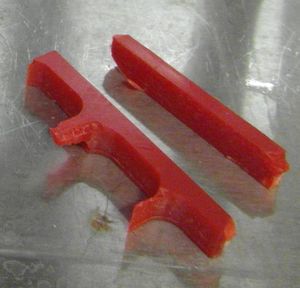Material:PVC: Difference between revisions
added photos |
m →Hard PVC: typo |
||
| Line 21: | Line 21: | ||
<br clear=all> | <br clear=all> | ||
== Hard PVC == | == Hard PVC == | ||
{{£}} has some "hard" red PVC scraps, some of | {{£}} has some "hard" red PVC scraps, some of substantial size. They can be [[milling|milled]], as verified by [[Patrick]] when he made some [[CNC Router|CNC routing]] holddowns out of a 1 cm thick piece. | ||
Further ideas include a ''Planscheibe'' for the [[Wood Lathe|wood lathe]], let us know if you have another use for this material! | Further ideas include a ''Planscheibe'' for the [[Wood Lathe|wood lathe]], let us know if you have another use for this material! | ||
Latest revision as of 06:04, 4 June 2018
| MaterialInfoBox Polyvinyl Chloride | |
|---|---|

| |
| Synonyms: | "vinyl"; DE: Polyvinylchlorid, "Vinyl" |
| On Site? | Lukas has some scraps |
| Suggested Tools: | scissors, scalpels, cutting plotter (for foil) |
Polyvinyl chloride (PVC) emits highly corrosive and toxic chlorine gas when melted and is therefore not allowed in a laser cutter!
Cutting PVC sheets with power saws is a bit less dangerous but should also only be attempted in well ventilated areas. It is still going to damage the tool or at least its blade over time, so make sure the owner is okay with it!
PVC foil is a bit easier to deal with: you can cut it with scissors, scalpels or a cutting plotter.

PVC is dissolved by acetone and can be glued with specialized adhesives.
Hard PVC
Lukas has some "hard" red PVC scraps, some of substantial size. They can be milled, as verified by Patrick when he made some CNC routing holddowns out of a 1 cm thick piece.
Further ideas include a Planscheibe for the wood lathe, let us know if you have another use for this material!